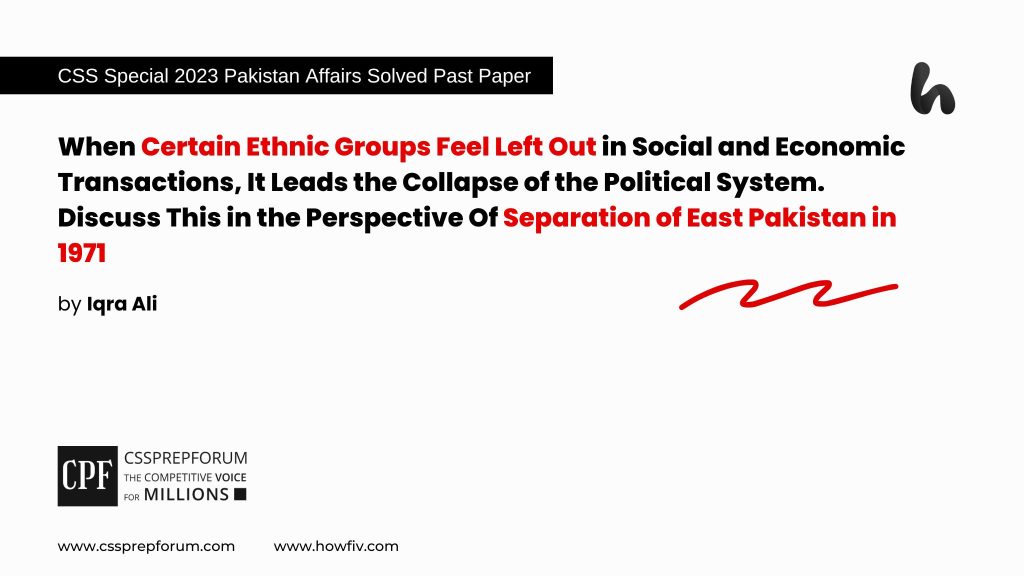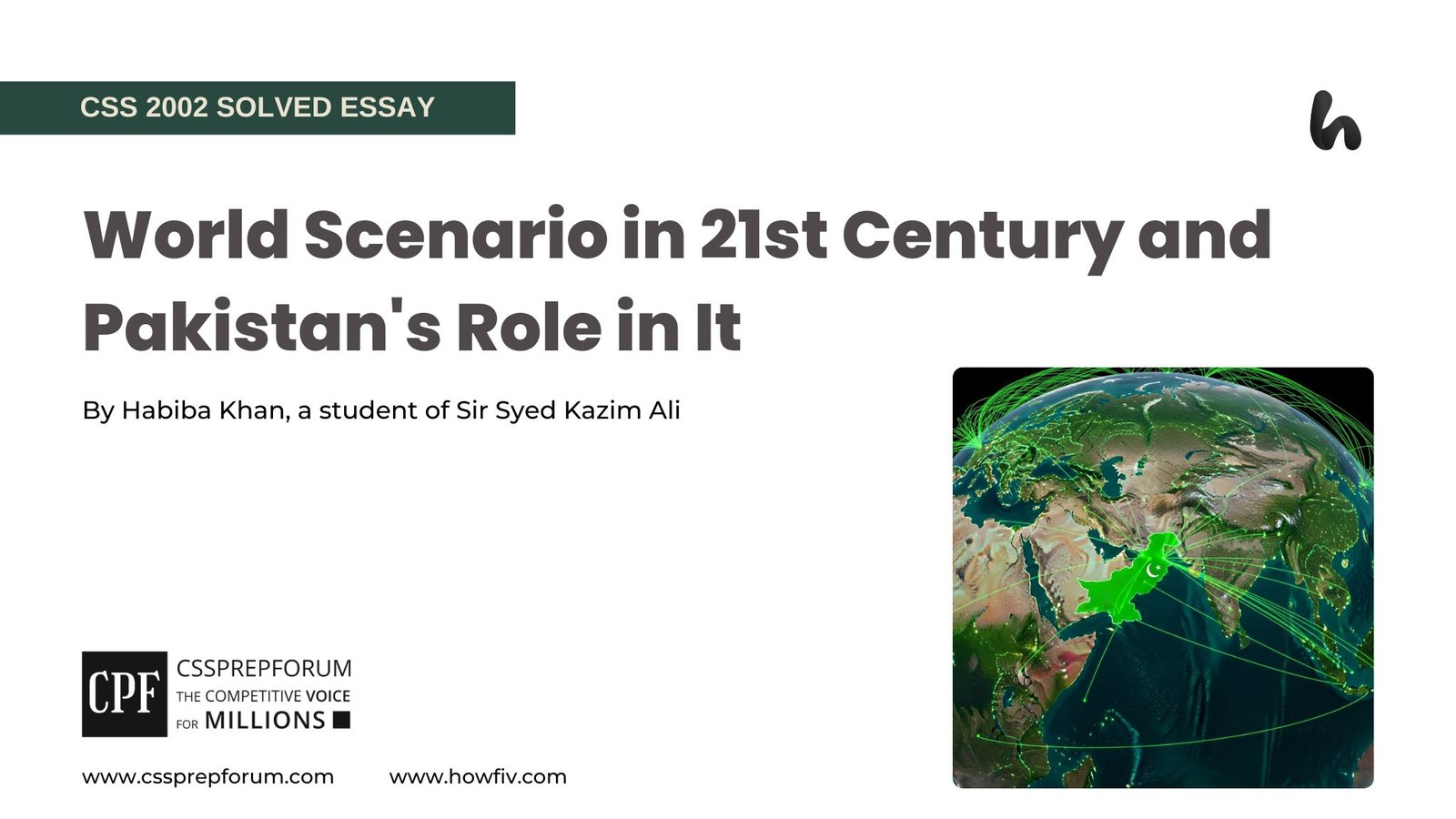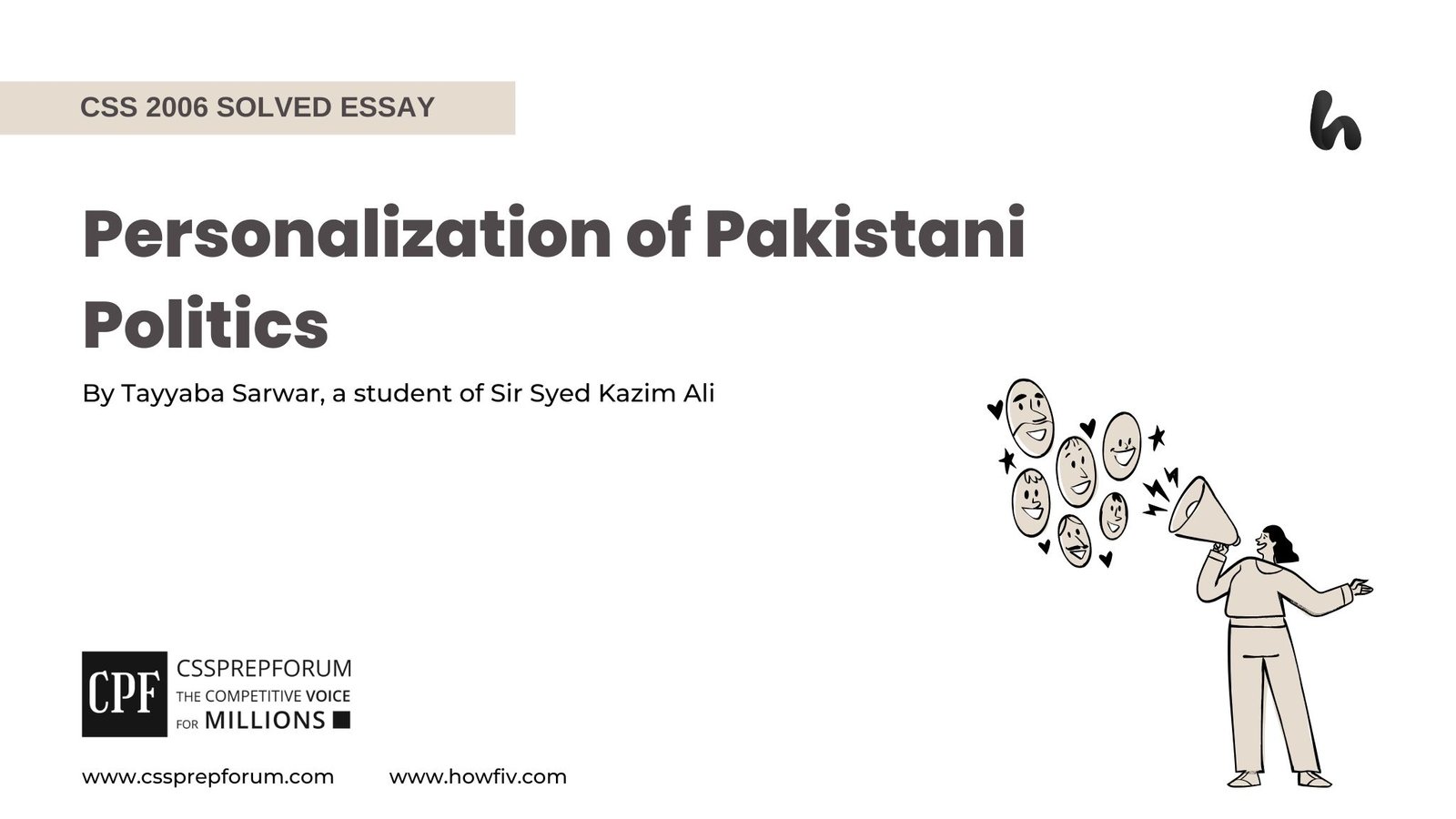CSS 2023 Special Solved Pakistan Affairs Past Papers | Ethnic Reasons for Separation of East Pakistan 1971
The following question of CSS Pakistan Affairs 2023 Special is solved by Miss Iqra Ali, Pakistan’s Best Pakistan Affairs Coach, on the guided pattern of Sir Syed Kazim Ali, which he taught to his students, scoring the highest marks in compulsory subjects for years. This solved past paper question is uploaded to help aspirants understand how to crack a topic or question, how to write relevantly, what coherence is, and how to include and connect ideas, opinions, and suggestions to score the maximum.

Question Breakdown
In this question, the examiner has asked you one leading thing how marginalization of Bengalis in socio-economic transactions led to the collapse of the political system of Pakistan? So, first, you need to briefly introduce your answer and provide historical background to contextualize your position. Then, provide your answer by splitting it into parts: first, about the social marginalization, and second, about the economic marginalization. Finally, end your answer with a critical analysis and conclusion. Remember, the following solved question provides a comprehensive answer covering all the main aspects. However, as far as the answer in the paper is concerned, limit yourself to 3 or 4 leading arguments against each part of the question.
Outline
1- Introduction
2- Historical Background of the Socio-Economic Conditions of East Bengal before and after the Partition of the Indian Subcontinent
3- How did the marginalization of Bengalis in socio-economic transactions lead to the collapse of the political system of Pakistan?
3.1- Social Marginalization of Bengalis
- ✓Bengalis Ached For the Acceptability of Their Ethnicity
- ✓ Bengali’s Fragile Presence in the Decision-Making, Army, and Civil Service Led the Way to Widespread Resentment across East Bengal
- ✓Unacceptability Of the Importance of Bengali Language by West Pakistan Led the Way to Widespread Bengali Nationalism and Politicization Of Ethnicity, Which Dwindled The Sense Of National Integrity
- ✓One Unit Formula Squeezed the Majority Population of Bengalis and Created Provincial Prejudices That Caused Resentment among the People across East Pakistan
- ✓Feeling of alienation among the Bengalis emerged as a result of these injustices
- ✓Neglection by the government during the Indo-Pak War of 1965 And Natural Disaster (Cyclone) in 1970
3.2- Economic Marginalization of the Bengalis
- ✓Economic Deprivation Was an Anathema for the Bengalis
- ✓ A Major Source Of Economy, The Jute, In East Pakistan Under The State Center Control, Echoes Heard For The Dissolution Of The Constitutional Assembly In 1954
- ✓Economic Degradation during the Ayyub Khan Regime Created Severe Regional Imbalances That Largely Contributed to the Breakup of East Pakistan
- ✓Abject Fiscal Disparities between East and West Pakistan in the 1960s
- ✓Lack Of Pay Parity and Development Initiatives in East Pakistan
- ✓AcuteDisparities in the Living and Educational Standards Created Discords between the People of the East and the West Pakistan
4- Critical Analysis
5- Conclusion

Answer to the Question
Introduction
A country with a diverse ethnolinguistic population enriches its culture; however, the disparities between these ethnic groups compromise its National unity and integrity. In addition, the lack of socio-economic equilibrium between such ethnicities creates discords among them. Unfortunately, in the case of Pakistan, the acute disparities between its diverse ethnolinguistic units created unprecedented discords between them, where these units become bastions of upheaval, and the prospects of their cooperation appear bleak. Historically, the socio-economic and political dominance of Punjab over the other provinces became a source of contention between the federating units. In the case of Eastern Bengal, dismembered in 1971, this socio-economic marginalization had contributed to its departure at large. At the time of partition in 1947, the already marginalized Muslims of Bengal aspired for better socio-economic opportunities. Unfortunately, their aspirations became miscalculations, as they concluded from their experiences since 1947. First, they did not get ethnic acceptance from the people of West Pakistan, which was more necessary for them than their religion. In the later years, their fragile presence in the decision-making cadre added fuel to the smouldering fire that came out of their burning aspirations. However, the Bengali vs Urdu dilemma threatened the Bengalis from the aspect of ethnic subjugation, and the fear resulted in the widespread Bengali nationalism, an anathema for national cohesion and integrity. In 1954, the merger of West Pakistan into one unit substantially decreased the prospects for socio-economic development and higher representation in the polity as a majority province. In the 1960s, Ayub Khan’s ruling period proved fruitful for the West Wing but disastrous for the East Wing. In addition, the dire conditions of the war of 1965, when people desperately wanted the support of the state, were unfortunately met with utter neglect. Second, the economic marginalization, which was anathema for the Bengalis, caused widespread resentment among the people of East Bengal. The state control over the largest sector of the East Wing economy, the jute, and then the transfer of the earned revenue to the West Wing disenchanted the people. This economic disparity contributed to the abject fiscal crisis, poor living standards, and underdevelopment of educational and other sectors. Moreover, all these obscure crises concluded with the political breakdown in 1971, the fall of Dhaka.
Historical Background of the Socio-Economic Conditions of East Bengal before and after the Partition of the Indian Subcontinent
In 1947, the country consisted of two parts: the West Wing consisted of four provinces, and 1000 miles apart, the East Wing was one province named East Bengal. The East Bengal was more backward and underdeveloped. So, the ethnic identity remained far more necessary for the Bengalis than their religion. It had the majority population, about 56 percent. Before partition, the Hindus, at large, were the principal landlords, public officers, men of learning, moneylenders, and traders. On the contrary, the Muslim majority in Bengal belonged to the peasant and daily wager classes. In some areas of East Bengal, Hindus owned 85 per cent of the town buildings. Hence, having a religious resemblance, they foresee a better future in the Muslim-majority country. But circumstances dashed their hopes. It started with a language controversy when Quaid-e-Azam, announced on 19th March 1948,
“Without one state language, no nation can remain solidly together and function …state language of Pakistan is going to be Urdu and no other language. Anyone who tries to mislead you is an enemy of Pakistan.”
First, they were under-represented in the army, Indian Civil Service, and Indian Police Service in the Indian Subcontinent because they supplied rebels in the War of Independence in 1857. Their aspirations for better representation in the decision-making class, being the majority province, did not succeed. Second, the one-unit formula squeezed the majority population of Bengalis. It merged all four provinces into one wing, the West Wing. Third, the economic deprivation of East Wing during the 1960s and sheer neglect in the war of 1965 further added fuel to the fire. Last but not least, the political discord between Zulfiqar Ali Bhutto and Mujjib-ur-Rehman ended in the fall of Dhaka. In 1971, a war fought between the East and West Wing and Bangladesh came into being.
How did the marginalization of Bengalis in socio-economic transactions lead to the collapse of the political system of Pakistan?
A- Social Marginalization of Bengalis
- ✓Bengalis Ached For the Acceptability of Their Ethnicity
Before 1947, the ethnic identity remained far more necessary for the Bengalis than their religion. However, its manifestation was in the Presidential address of Abdul Mansoor Ahmad, the President of the Bengali Muslim League, in 1944. According to him, religion and culture are not the same thing. Religion transgresses the geographical boundary, but tammadun (culture) cannot go beyond the geographical boundary. For this reason, the people of Purba (East Pakistan) are a different nation from the people of other provinces of India and the ‘religious brothers’ of Pakistan. Although the majority population of East Bengal was Muslim, the Hindus dominated the public and the economic sphere. Hence, the Bengali Muslims, while responding to the call of the All India Muslim League (AIML), aspired for their ethnic acceptability and better position in the socio-economic fields. Unfortunately, they did not get the level of acceptability they deemed neither in society nor the economic field.
- ✓ Bengali’s Fragile Presence in the Decision-Making, Army, and Civil Service Led the Way to Widespread Resentment across East Bengal
First, the Bengalis remained frustrated by their fragile presence in the army, Indian Civil Service, and Indian Police Service before the partition of the Indian Subcontinent, which obstructed them from being part of the decision-making. But after 1947, they hoped for better representation in the decision-making cadres of the country. Unfortunately, even the quota of 40 percent for the inclusion of Bengalis in Civil Service (against 23 percent for Punjabis) introduced in 1949 to make up for their socio-economic backwardness had failed to address the problem effectively. The following chart explains the acute representation of East Wing as compared to West Wing in the decision making cadre in 1947.
| Total Number | Bengali | |
| 1947- Civil Servants in IPS and ICS | 101 | 81 |
| 1950s- Civil Servants | 741 | 51 |
| 1955-Army officers of higher ranks | 308 | 1 Bengali brigadier, 1 colonel, and 2 lieutenant colonels |
Like other provinces of Pakistan in the 1950s, East Pakistan felt alienated. According to Ishrat Hussain, in his book, Governing the Ungovernable, In the 1950s, the Punjabization of Pakistan sowed the seeds of mistrust among the provinces on the part of the state. However, the demand for representation had created inter-provincial and centre-provincial feuds and sowed the seeds of discord. According to Ian Talbot in his book Pakistan a New History, the greatest resentment expressed by Sindhi and Bengali leaders in the 1950s was the lack of influence in the bureaucracy and army. East Bengal, being the most populous province of the country (56% of the total population), demanded a significant presence at the centre and in the decision-making cadre. The following chart explains the acute representation of the East Wing as compared to the West Wing in the Central Secretariat Posts and army elites in the 1950s.
.
| Central Secretariat Elite Posts and Army Elites- 1950s | East Bengal | West Pakistan |
| Secretary | 0 | 19 |
| Joint Secretary | 3 | 38 |
| Deputy Secretary | 10 | 123 |
| LT GEN | 0 | 3 |
| MAJ GEN | 0 | 20 |
| BRIG | 1 | 34 |
- ✓Unacceptability Of the Importance of Bengali Language by West Pakistan Led the Way to Widespread Bengali Nationalism and Politicization Of Ethnicity, Which Dwindled The Sense Of National Integrity
Second, the unacceptability of the importance of the Bengali language by West Pakistan led the way to widespread Bengali nationalism and politicization of their ethnicity, which dwindled the sense of national integrity. The language controversy was the first ostensible clash between the two wings; however, it started when Bengali leaguers opposed the proclamation of Jinnah that Urdu would be the national language of Pakistan. In 1948, the issue was raised in the first constitutional assembly by Direndra Nath Datta and other Hindu members of the Pakistan National Congress. In 1948, Jinnah announced Urdu as the national language. Later, he accepted Bengali as the provincial language, causing fierce resentment among Bengali students. In addition, a massive demonstration was held by the students of Dhaka University against Prime Minister Khawaja Nazimuddin’s announcement that “Urdu will be the State language.” However, the death of a Bengali student laid the basis for Bengali Nationalism. Moreover, this language movement, in the absence of national integration, politicized the Bengali ethnicity, which added fuel to the miscreants that contributed to the collapse of the political system in 1971.
- ✓One Unit Formula Squeezed the Majority Population of Bengalis and Created Provincial Prejudices That Caused Resentment among the People across East Pakistan
Third, the one-unit formula squeezed the majority population of Bengalis and created provincial prejudices that caused resentment among the people across East Pakistan. It was passed on Sep 30, 1955, by the then Prime Minister Muhammad Ali Bogra, a Bengali Politician; however, it merged all four provinces into one wing, the West Wing. The problem started in 1952 when the Basic Principle Committee recommended a bicameral legislature with the parity of representation. This step will automatically deprive the Bengalis of the benefits of being the majority, so criticized widely in the East Wing. Khuwaja Nazimuddin, the Bengali and the President of the First Constitutional Assembly called for consensus that resulted in the consensus of 16 out of 29 members. Then, Governor General Muhammad Ali Bogra presented a formula that gave them more share in the lower house (165/300) and parity in the upper house. Unfortunately, before the acceptance, the assembly was dissolved by Governor General Muhammad Ali in 1954. Their resentment could be seen in the slang Sala Punjabi that echoed in the streets of East Pakistan
- ✓Feeling of alienation among the Bengalis emerged as a result of these injustices
Fourth, from parity to the disparity between the east and the west wing, disenchanted Bengalis always felt alienated. It happened under the strong centralization of the Ayub Khan rule, where Bengalis were neglected deliberately in the socio-economic fields. The period could regarded as the route to ethnic divisions that led to the debacle of East Pakistan. They outcried, busted, frustrated, felt alienated, and wanted freedom. What added fuel to the fire was the controlled polity? According to Ishtiaq Ahmed, as he aptly said in his book Pakistan: A Garrison State, Ayyub Khan appointed Monem Khanas the Governor of East Pakistan on October 25th, 1962 (1962 to 1968). He ruled East Pakistan with a ruthless hand, carrying out grotesque undemocratic and autocratic plans and policies on behalf of Ayub Khan. In contrast, the Bengalis raised their voices for Governor Azam Khan. Later, their hopes for the rule of Fatima Jinnah met with failure. These created a sense of fear, insecurity, and marginalization among the Bengalis.
- ✓Neglection by the Government during the Indo-Pak War of 1965 And Natural Disaster (Cyclone) in 1970
Fifth, the East Wing was neglected by the central government in the War of 1965. According to a Bengali jurist, Kamal Housain, during the war of 1965, the eastern wing experienced a sense of isolation; it felt exposed and undefended. East Pakistan had no security arrangement when India decided to move its armies in the 1965 war. In addition, a cyclone hit in November 1971. According to the report, East Some 500,000 people living in the swaths of the coastal areas of East Pakistan are estimated to have died. Unfortunately, the government reached ten days later, and they were dealt with utter neglect. The tragedy was enough to prove that their future may not be as secure as their past.
B- Economic Marginalization of the Bengalis
- ✓Economic Deprivation Was an Anathema for the Bengalis
The economic deprivation was an anathema for the Bengalis. Before partition, the Hindus dominated the middle class of Eastern Bengal. According to the 1871 census report, the Hindus, at large, were the principal landlords, public officers, men of learning, moneylenders, and traders. On the contrary, the Muslim majority in Bengal belonged to the peasant and daily wager classes. In some areas of East Bengal, Hindus owned 85 percent of the town buildings. The Bengalis deemed a better socio-economic standing in the Muslim-majority country. Hence, they responded quickly to the call of the All-India-Muslim-League. (AIML).
- ✓ A Major Source Of Economy, The Jute, In East Pakistan Under The State Center Control, Echoes Heard For The Dissolution Of The Constitutional Assembly In 1954
First, when the leadership of united Pakistan made efforts for a strong centralization, East Bengal demanded the dissolution of the Constitutional Assembly after the general elections of East Bengal. The reason was the state control over the jute export, which largely contributed to the economic prosperity of the eastern province.
- ✓Economic Degradation during the Ayyub Khan Regime Created Severe Regional Imbalances That Largely Contributed to the Breakup of East Pakistan
Second, the Ayub Khan neglected the development of the East Wing. He ordered the transfer of 2.5 billion dollars earned from the export of jute from the East Wing to the West Wing. However, the economic degradation of the agrarian society during his regime created severe regional imbalances that largely contributed to the separation of East Pakistan. The following chart explains difference between the constituted and received state revenue of the East wing from the exports.
| Total Export of the State Revenue of the East Wing | Constituted | Received |
| 60–70% | 25-30% |
- ✓Abject Fiscal Disparities between East and West Pakistan in the 1960s
Third, the abject fiscal disparities between the East and the West Pakistan in the 1960s created by the neglect created havoc. Ayub Khan abolished the Planning Board that worked for the development of East Pakistan. Furthermore, the economic shares also decreased substantially. The following charts explains the percentage of total share received by East wing for the development of its semi-public institutions during 1956-1961.
| 1956 -1961 Total share of the East Wing in the Semi-Public Institutions | Industrial Development Bank | House Building Finance Corporation | Pakistan Industrial Credit and Investment Corporation |
| 20 percent | 12 percent | 24 percent |
- ✓Lack Of Pay Parity and Development Initiatives in East Pakistan
Fourth, the lack of pay parity further aggravated the problem. According to a report, during the rule of Ayub Khan, there was a gap of 30 per cent in the per capita income between the Wings. In 1965, the gap was increased from 30 to 45 %; however, it increased to 61% by the end of Ayub Khan’s term. As I discussed earlier, the lack of development initiatives marred the economic growth in East Pakistan.
- ✓Acute Disparities in the Living and Educational Standards Created Discords between the People of the East and the West Pakistan
At last, the economic disparities created acute differences in the living standards of the wings. The Gross provincial product was 1237.4 crore rupees for East Pakistan and 1209.1 for West Pakistan in 1950. But in the later years, the GPP grew to Rs1867.1 crore for East Pakistan and Rs.2009 crore for West Pakistan. However, the increasing gap aggravated a sense of marginalization among the people, and open discords happened between the representatives, which ended in 1971. The following table shows fiscal disparities in allotting funds for education, where the West Wing grew more.

Critical Analysis
In robust analysis, parity in economic and political share is indispensable for the survival of an ethnically diverse country. However, the preservation of the ethnic identity ensures national cohesion and integration. In contrast, the dominance of one province over the other creates a sense of marginalization. As this happened in the case of East Bengal, they felt alienated not only because of the territorial distance or socio-economic marginalization but also because the units of the same country were growing fantastically. Their due shares were not allowed by the state; they did not get cultural acceptance, and they feared ethnic subjugation because of the language crisis. At last, the acute disparities created widespread resentment among people. To conclude, their experience made them unable to see a bright future, and they decided to take refuge in their own independent country.
Conclusion
To conclude, Pakistan came into being in 1947 as an independent country. At that time, the country consisted of two parts: the Western part consisted of four provinces, and the Eastern part was one province named East Bengal. However, all the provinces of the country were ethnically diverse. East Bengal had the majority population, about 56 per cent. However, it was more backward and underdeveloped in a Hindu-dominated middle class. Having the religious similarity, they aspired for better opportunities in a Muslim-majority country. Unfortunately, they did not get what they deemed before partition. From 1947-71, the economic and social marginalization of the East Wing contributed to the debacle of the dismemberment of East Pakistan in 1971. From underdevelopment to marginalization in the socio-economic field, all factors played a significant role in the breakup of the united country. As a result, East Bengal separated from West Pakistan, and Bangladesh came into being in 1971.
CSS Special 2023 Solved Pakistan Affairs
CSS Solved Past Papers’ Essays
Looking for the last ten years of CSS and PMS Solved Essays and want to know how Sir Kazim’s students write and score the highest marks in the essays’ papers? Then, click on the CSS Solved Essays to start reading them.
CSS Solved Essays
CSS Solved General Science & Ability Past Papers
Want to read the last ten years’ General Science & Ability Solved Past Papers to learn how to attempt them and to score high? Let’s click on the link below to read them all freely. All past papers have been solved by Pakistan’s top CSS GSA coach having the highest score of their students.
General Science & Ability Solved Papers












